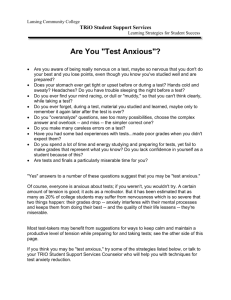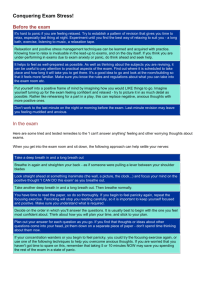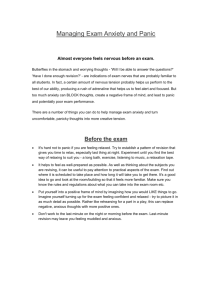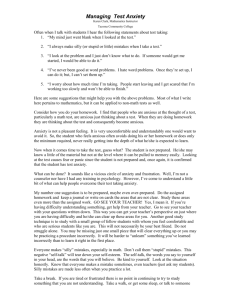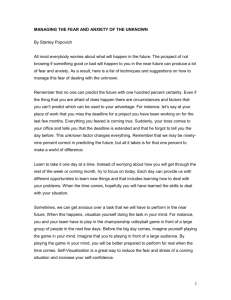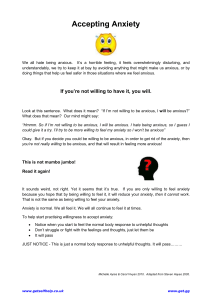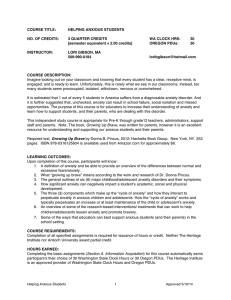Ten Tips to Alleviate Anxiety Talk It Out: Talking through what's
advertisement
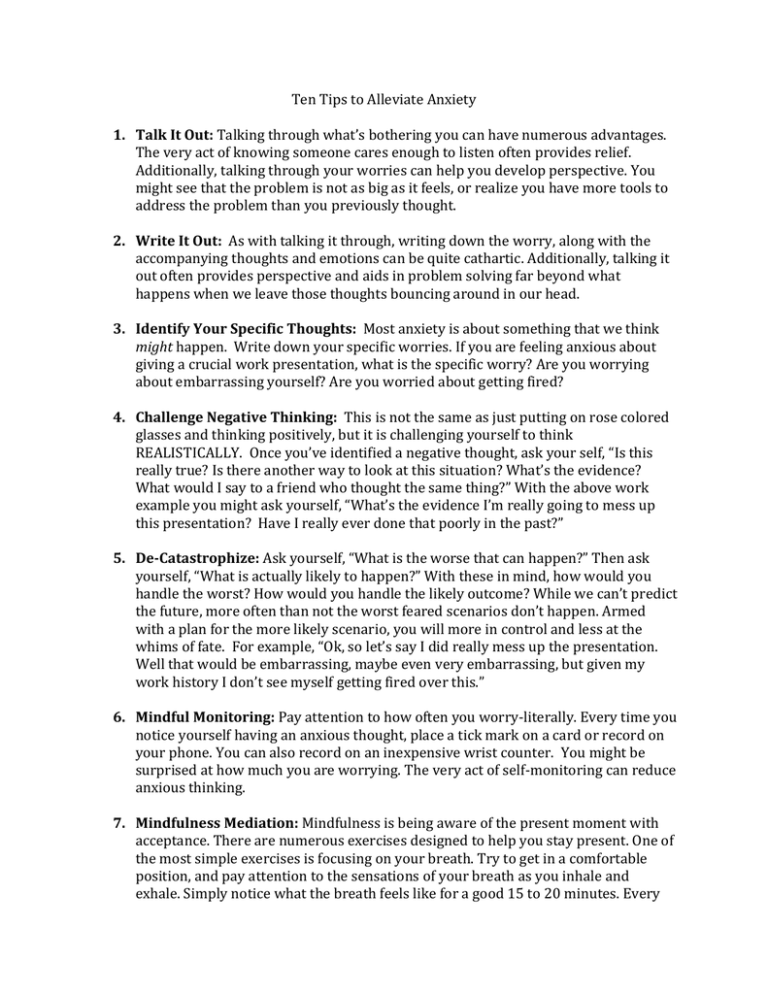
Ten Tips to Alleviate Anxiety 1. Talk It Out: Talking through what’s bothering you can have numerous advantages. The very act of knowing someone cares enough to listen often provides relief. Additionally, talking through your worries can help you develop perspective. You might see that the problem is not as big as it feels, or realize you have more tools to address the problem than you previously thought. 2. Write It Out: As with talking it through, writing down the worry, along with the accompanying thoughts and emotions can be quite cathartic. Additionally, talking it out often provides perspective and aids in problem solving far beyond what happens when we leave those thoughts bouncing around in our head. 3. Identify Your Specific Thoughts: Most anxiety is about something that we think might happen. Write down your specific worries. If you are feeling anxious about giving a crucial work presentation, what is the specific worry? Are you worrying about embarrassing yourself? Are you worried about getting fired? 4. Challenge Negative Thinking: This is not the same as just putting on rose colored glasses and thinking positively, but it is challenging yourself to think REALISTICALLY. Once you’ve identified a negative thought, ask your self, “Is this really true? Is there another way to look at this situation? What’s the evidence? What would I say to a friend who thought the same thing?” With the above work example you might ask yourself, “What’s the evidence I’m really going to mess up this presentation? Have I really ever done that poorly in the past?” 5. De-Catastrophize: Ask yourself, “What is the worse that can happen?” Then ask yourself, “What is actually likely to happen?” With these in mind, how would you handle the worst? How would you handle the likely outcome? While we can’t predict the future, more often than not the worst feared scenarios don’t happen. Armed with a plan for the more likely scenario, you will more in control and less at the whims of fate. For example, “Ok, so let’s say I did really mess up the presentation. Well that would be embarrassing, maybe even very embarrassing, but given my work history I don’t see myself getting fired over this.” 6. Mindful Monitoring: Pay attention to how often you worry-literally. Every time you notice yourself having an anxious thought, place a tick mark on a card or record on your phone. You can also record on an inexpensive wrist counter. You might be surprised at how much you are worrying. The very act of self-monitoring can reduce anxious thinking. 7. Mindfulness Mediation: Mindfulness is being aware of the present moment with acceptance. There are numerous exercises designed to help you stay present. One of the most simple exercises is focusing on your breath. Try to get in a comfortable position, and pay attention to the sensations of your breath as you inhale and exhale. Simply notice what the breath feels like for a good 15 to 20 minutes. Every time your mind wanders (which it will, REPEATEDLY), simply redirect your mind, without criticizing yourself, to pay attention to your breath. (For more information on mindfulness, please see…..) 8. If You Can’t Beat ‘Em, Join ‘Em: Instead of criticizing yourself for feeling anxious, acknowledge that you are. A lot of people are—(**) percent of the population at any one time, as a matter of fact. You can still work to overcome your anxiety without piling on needless and counter-productive self-criticism and shame. 9. What’s the real problem: Sometimes we inadvertently use our anxiety to mask another underlying feeling. Stop and think, “Is there some other problem I need to address?” Is there someone else I’m upset with and I’ve been afraid to talk with?” Is there a decision I’ve been putting off?” If you find yourself worrying over things that you know rationally don’t deserve the attention you are giving them, try to figure out if there is some other problem or relationship that is bothering you. Is this a problem that can be dealt with in some proactive way? Mindfulness exercises can be very helpful in becoming aware of underlying issues. 10. Just Do It! You may have done many of the above techniques and find that you still feel anxious about facing certain situations. This is because often talking about a fear will not alleviate the anxiety as much as facing a fear. The old adage, “If you fall of a horse, get back on it,” comes from the wisdom that avoidance, while providing temporary relief, only increases the actual fear. Yes, tremendously easier said than done, or you probably wouldn’t be reading these tips in the first place. See if you can start out in smaller, more incremental steps. If you have an elevator phobia, for example, first stand in front of the elevator. Then stand in an open elevator. Then go up and down only one floor. Moving stepwise closer to the feared situation and STAYING THERE until the anxiety actually goes down (and eventually it will) trains your body and your mind that there really is nothing to fear. What a tremendous step to overcoming your anxiety!

